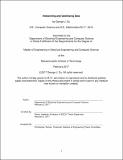| dc.contributor.advisor | Tommi Jaakkola. | en_US |
| dc.contributor.author | Du, George J | en_US |
| dc.contributor.other | Massachusetts Institute of Technology. Department of Electrical Engineering and Computer Science. | en_US |
| dc.date.accessioned | 2017-12-20T17:24:52Z | |
| dc.date.available | 2017-12-20T17:24:52Z | |
| dc.date.copyright | 2017 | en_US |
| dc.date.issued | 2017 | en_US |
| dc.identifier.uri | http://hdl.handle.net/1721.1/112840 | |
| dc.description | Thesis: M. Eng., Massachusetts Institute of Technology, Department of Electrical Engineering and Computer Science, 2017. | en_US |
| dc.description | This electronic version was submitted by the student author. The certified thesis is available in the Institute Archives and Special Collections. | en_US |
| dc.description | Cataloged from student-submitted PDF version of thesis. | en_US |
| dc.description | Includes bibliographical references (pages 28-29). | en_US |
| dc.description.abstract | The goal of this research was twofold. The first goal was to use observational data to propose interventions under various constraints, without explicitly inferring a causal graph. These interventions may be optimized for a single individual within a population, or for an entire population. Under certain assumptions, we found that is possible to provide theoretical guarantees for the intervention results when we model the data with a Gaussian process. The second goal was to map various data, including sentences and medical images, to a simple, understandable latent space, in which an intervention optimization routine may be used to nd beneficial interventions. To this end, variational autoencoders were used. We found that while the Gaussian process technique was able to successfully identify interventions in both simulations and practical applications, the variational autoencoder approach did not retain enough information about the input to be competitive with current approaches for classication, such as deep CNNs. | en_US |
| dc.description.statementofresponsibility | by George J. Du. | en_US |
| dc.format.extent | 29 pages | en_US |
| dc.language.iso | eng | en_US |
| dc.publisher | Massachusetts Institute of Technology | en_US |
| dc.rights | MIT theses are protected by copyright. They may be viewed, downloaded, or printed from this source but further reproduction or distribution in any format is prohibited without written permission. | en_US |
| dc.rights.uri | http://dspace.mit.edu/handle/1721.1/7582 | en_US |
| dc.subject | Electrical Engineering and Computer Science. | en_US |
| dc.title | Interpreting and optimizing data | en_US |
| dc.type | Thesis | en_US |
| dc.description.degree | M. Eng. | en_US |
| dc.contributor.department | Massachusetts Institute of Technology. Department of Electrical Engineering and Computer Science | |
| dc.identifier.oclc | 1015201941 | en_US |
